FAMILY MISTLETOE Portrait Series
In Family Mistletoe I have raised the possibility of an alternative model to the family tree. Informed by the work of ecologist David Watson, I am interested in Australian Mistletoe and the pivotal role it plays in its natural habitats. Historically, Australian Mistletoe has been largely ignored or regarded as a menace to the trees it inhabits. However, contemporary ecological engagements with mistletoe identify it as a ‘keystone’ plant that reflects, rather than being the cause of, either a healthy or a disturbed eco-system.
Using leaves from mistletoe plants to create dyes and screenprinting inks I have printed fabrics from which I have sewn a series of six garments, each a subsequent generation from one family. These garments have then formed the props for two series of portraits. I am interested in how gender relations are reflected in historical knowledge. Like mistletoe, women are keystones, vital for the formation of the family tree, yet historically represented as incidental, perhaps even as parasites.
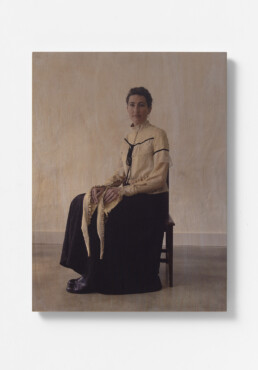
Maria 1802-1847
2010
UV ink on ply (dress: screenprint using mistletoe dye on cotton)
640 x 480 x 19mm
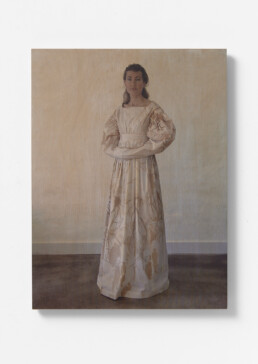
Henrietta 1851-1921
2010
UV ink on ply (shirt: screenprint using mistletoe dye on silk, Irish lace, velvet ribbon)
640 x 480 x 19mm
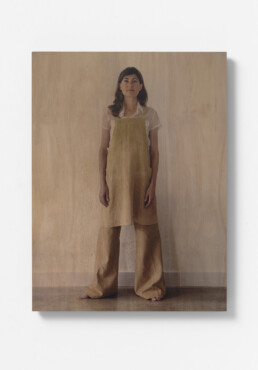
Clarice 1890-1957
2010
UV ink on ply (dress: screenprint using mistletoe dye on cotton and linen)
640 x 480 x 19mm
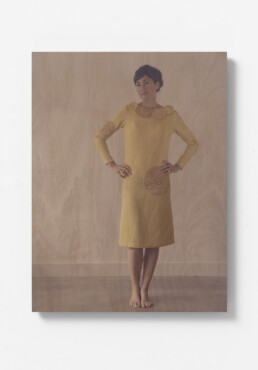
Janet 1915-1995
2010
UV ink on ply (nightgown: screenprint using mistletoe dye on silk)
640 x 480 x 19mm
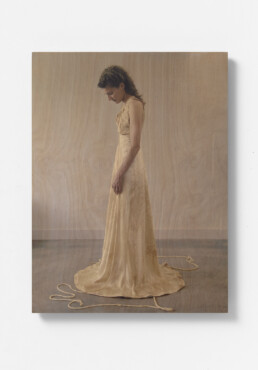
Margaret 1945 –
2010
UV ink on ply (nightgown: screenprint using mistletoe dye on silk)
640 x 480 x 19mm
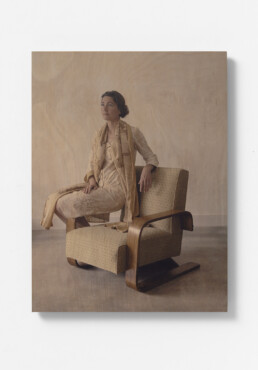
Frances 1971 –
2010
UV ink on ply (apron: mistletoe dye on linen, trousers: screenprint using mistletoe dye on hemp)
640 x 480 x 19mm
Landscape Series
The Landscape Series of portraits is the second portrait series using the mistletoe garments. Here a dancer moves within the confines of her garment. The constraints and possibilities offered by each reflect the small shifts offered to each new generation of women. Situated within a traditional photographic studio, complete with the illusion of a canvas backdrop, a constructed ‘natural’ landscape surrounds the dancer, testing the cultural meanings inherent in these environments.
Printed onto the rear face of 4mm glass, and screenprinted with gold gouache, this series uses digital printing techniques to mimic obsolete and moribund glass slide processes.
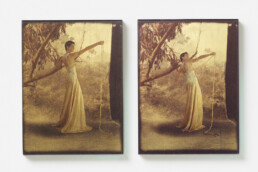
2010
Clarice 1890-1957
UV Ink and screenprint on glass, (garments: screenprinted and dyed using mistletoe dye)
16 x 12cm
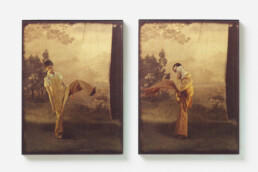
2010
Maria 1802-1847
UV Ink and screenprint on glass, (garments: screenprinted and dyed using mistletoe dye)
16 x 12cm
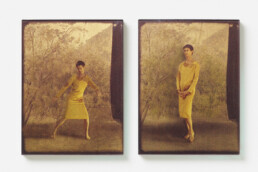
2010
Henrietta 1851-1921
UV Ink and screenprint on glass, (garments: screenprinted and dyed using mistletoe dye)
16 x 12cm
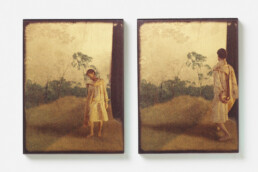
2010
Janet 1915-1995
UV Ink and screenprint on glass, (garments: screenprinted and dyed using mistletoe dye)
16 x 12cm
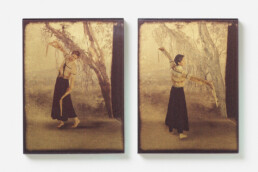
2010
Margaret 1945 –
UV Ink and screenprint on glass, (garments: screenprinted and dyed using mistletoe dye)
16 x 12cm
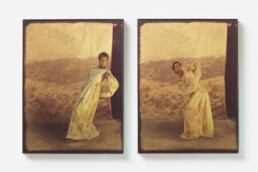
2010
Frances 1971 –
UV Ink and screenprint on glass, (garments: screenprinted and dyed using mistletoe dye)
16 x 12cm
RMIT Project Space/Spare RoomRegeneration2010
Marian Crawford
Rebecca Mayo
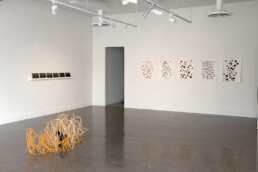
RMIT Project Space (installation view)
2010
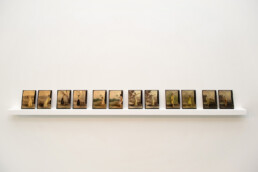
Family Mistletoe Landscape Series
2010
UV Ink and screenprint on glass, (garments: screenprinted and dyed using mistletoe dye)
16 x 12cm
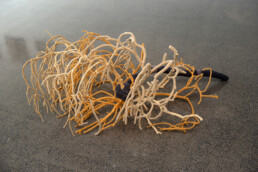
Family Mistletoe VIII
2010
Mistletoe branch, felted recycled jumpers, thread
Variable dimensions